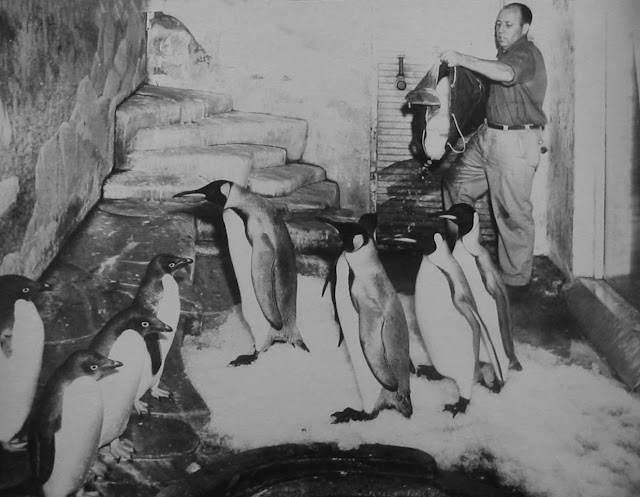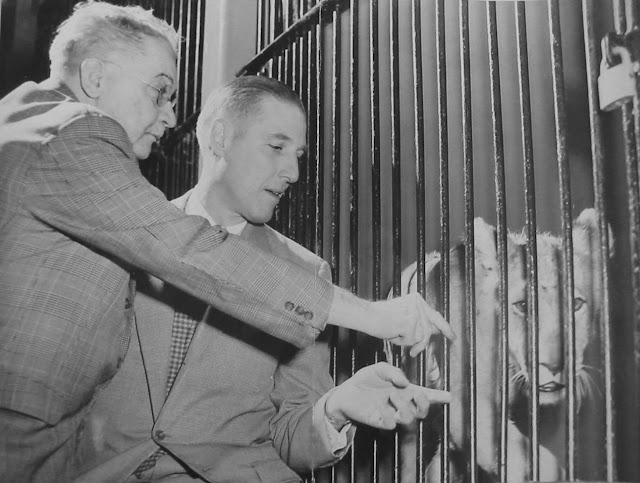 |
| A five member band and a dancer entertain the polar bears in the 1920s. |
Since the
National Zoo’s inception in 1889, many Woodley Park
residents, including those at the nearby Kennedy-Warren apartment building,
have awoken to the sounds of lions growling, wolves howling, and other animal
noises from their four-legged neighbors.
Designed by the famed architectural landscape firm of Frederick Law
Olmstead, who was also responsible for the design of Central
Park and the U.S. Capitol Grounds, the National Zoo has evolved
from a showcase of the world’s exotic species to a conservation organization,
public education pioneer, as well as a scientific research organization. Of
course, adorable pandas, monkeys, and tigers are still the main attraction.
 |
| Charles Trevey bakes huge loaves of bread for the bears in August of 1922 |
Created by an 1889 Act of
Congress for "the advancement of science and the instruction and
recreation of the people," the National Zoo became part of the Smithsonian
Institution in 1890. In addition to the
main 163-acre urban park in the Rock
Creek Valley,
the Zoo also has a 3,200-acre Conservation and Research Center
in Front Royal, Virginia. The Zoo's
spacious and picturesque area marked a significant departure from the 19th
century philosophy of creating zoos in small areas. Due to its origin prior to the creation of New York's Zoological Park and Munich's Hellabrun Zoo, the National Zoo may
have been the first zoo to be located in such a spacious park-like setting.
 |
| A little ice is provided tot he penguins by bird keeper Holmes Vourous in 1954 |
Plans for the Zoo were drawn by
three individuals — Samuel Langley, third secretary of the Smithsonian; William
Temple Hornaday, a conservationist and head of the Smithsonian's vertebrate
division; and Frederick Law Olmstead, a leading landscape architect who
designed Central Park in New York. Historians
at the zoo, however, indicate that the first recorded live animal gift to the
nation occurred in 1785, when Charles III of Spain sent a “royal jackass” to
George Washington while he resided at Mount
Vernon.
 |
| Watch those fingers - Director William Mann (left) and Wm Mileham in January 1951 |
The Zoo has been at the
forefront in striving to expand the public's knowledge of the wildlife and the
environment through public education programs aimed at teachers and school
children, with images of Victorian school children common in the collection of
zoo images at the Library of Congress. The first animals at the facility were
literally captured in the wild and brought back to Washington.
The zoo also strove in the early years of its existence to create a
refuge for buffaloes and other animals that were quickly disappearing from the North America landscape. The present monkey house, the New Mammal
House, and the lion house are the only two original Zoo buildings that remain
today.
 |
| A Chimpanzee enjoys a refreshing bottle of milk in May of 1926 |
Despite Washington's long, humid summers, polar
bears seem unaffected by the heat at the National Zoo. Past polar bears have resided at the Zoo for
more than 25 years without showing ill affects of the heat. This wacky photograph shows staff members swimming in their pool in 1973. The chimpanzees are known to be one of the
easiest species for the Zoo to exhibit due to their pleasant demeanor and
friendly attitude toward spectators and keepers. Others were no so easily contained: Kechil, a
ten-year-old elephant that had been caught in Sumatran, was known in 1932 as
the "bad boy" of the park, able to throw “with good aim rocks which
have been tossed into his enclosure, and has been known to hit visitors on the
head,” according to a 1936 book on the zoo.
 |
| The first director of the zoo, Wm Blackburne, who served for more than 40 years, with a gorilla named N'Gi |
|
|
|





